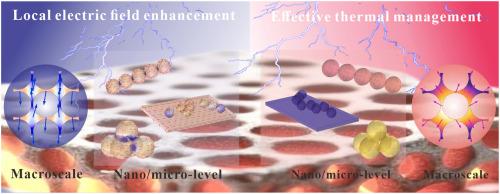Deep insights into the stealth enhancement mechanism of polyimide composite foams containing embedded heterogeneous structures for low infrared emissivity and broadband radar stealth
IF 11.6
2区 材料科学
Q1 CHEMISTRY, PHYSICAL
引用次数: 0
Abstract
The multifunctional coupling effect of multi-scale composite materials opens up a highly promising path for the development of radar/infrared compatible stealth materials. However, scale mismatch and limited in-situ characterization techniques make it difficult to obtain a quantitative explanation for the stealth mechanism of multiscale composite systems, which seriously restricts the development of related materials and the further improvement of their performance. In this study, polyimide/carbon black/graphene sheets (PI/CB/GSs) composite foams are successfully prepared, and the stealth enhancement mechanisms of structures and components at different scales are decoupled and revealed by experiments and simulations. The linear, nanoscale distribution of CB nanoparticles within the matrix reduces the heat accumulation from infrared absorption, thereby facilitating infrared stealth. The presence of large-diameter GSs achieves effective thermal management by delaying temperature rise and evenly distributing heat. Electric field reconstruction formed by microwave-induced electronic anisotropy drives excellent microwave attenuation. As a result, the PI/CB/GSs-III foam exhibits a low infrared emissivity of 0.39 in the 8–14 μm wavelength band and a broad effective absorption bandwidth of 15 GHz with a minimum reflection loss of −48.74 dB. This work breaks through the previous qualitative understanding of the stealth mechanism of carbon materials in composite systems and reveals their stealth enhancement mechanism in a semi-quantitative manner, providing key support for quantitative research in this field.

低红外发射率和宽带雷达隐身性能的嵌入式异质结构聚酰亚胺复合泡沫增强隐身机理的深入研究
多尺度复合材料的多功能耦合效应为雷达/红外兼容隐身材料的发展开辟了一条非常有前途的道路。然而,由于尺度失配和原位表征技术的限制,难以对多尺度复合材料体系的隐身机理进行定量解释,严重制约了相关材料的发展和性能的进一步提高。本研究成功制备了聚酰亚胺/炭黑/石墨烯片(PI/CB/GSs)复合泡沫,并通过实验和模拟揭示了不同尺度下结构和组分的隐身增强机制。炭黑纳米颗粒在基体中的线性纳米级分布减少了红外吸收的热量积累,从而促进了红外隐身。大直径GSs的存在通过延缓温度上升和均匀分布热量实现了有效的热管理。微波诱导电子各向异性形成的电场重构驱动了优异的微波衰减。结果表明,PI/CB/GSs-III泡沫在8 ~ 14 μm波段的红外发射率为0.39,有效吸收带宽为15 GHz,最小反射损耗为−48.74 dB。本工作突破了以往对复合体系中碳材料隐身机理的定性认识,以半定量的方式揭示了其隐身增强机理,为该领域的定量研究提供了关键支撑。
本文章由计算机程序翻译,如有差异,请以英文原文为准。
求助全文
约1分钟内获得全文
求助全文
来源期刊

Carbon
工程技术-材料科学:综合
CiteScore
20.80
自引率
7.30%
发文量
0
审稿时长
23 days
期刊介绍:
The journal Carbon is an international multidisciplinary forum for communicating scientific advances in the field of carbon materials. It reports new findings related to the formation, structure, properties, behaviors, and technological applications of carbons. Carbons are a broad class of ordered or disordered solid phases composed primarily of elemental carbon, including but not limited to carbon black, carbon fibers and filaments, carbon nanotubes, diamond and diamond-like carbon, fullerenes, glassy carbon, graphite, graphene, graphene-oxide, porous carbons, pyrolytic carbon, and other sp2 and non-sp2 hybridized carbon systems. Carbon is the companion title to the open access journal Carbon Trends. Relevant application areas for carbon materials include biology and medicine, catalysis, electronic, optoelectronic, spintronic, high-frequency, and photonic devices, energy storage and conversion systems, environmental applications and water treatment, smart materials and systems, and structural and thermal applications.
 求助内容:
求助内容: 应助结果提醒方式:
应助结果提醒方式:


